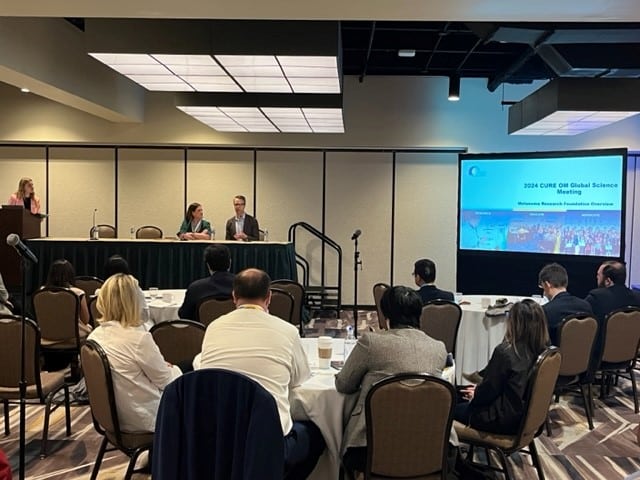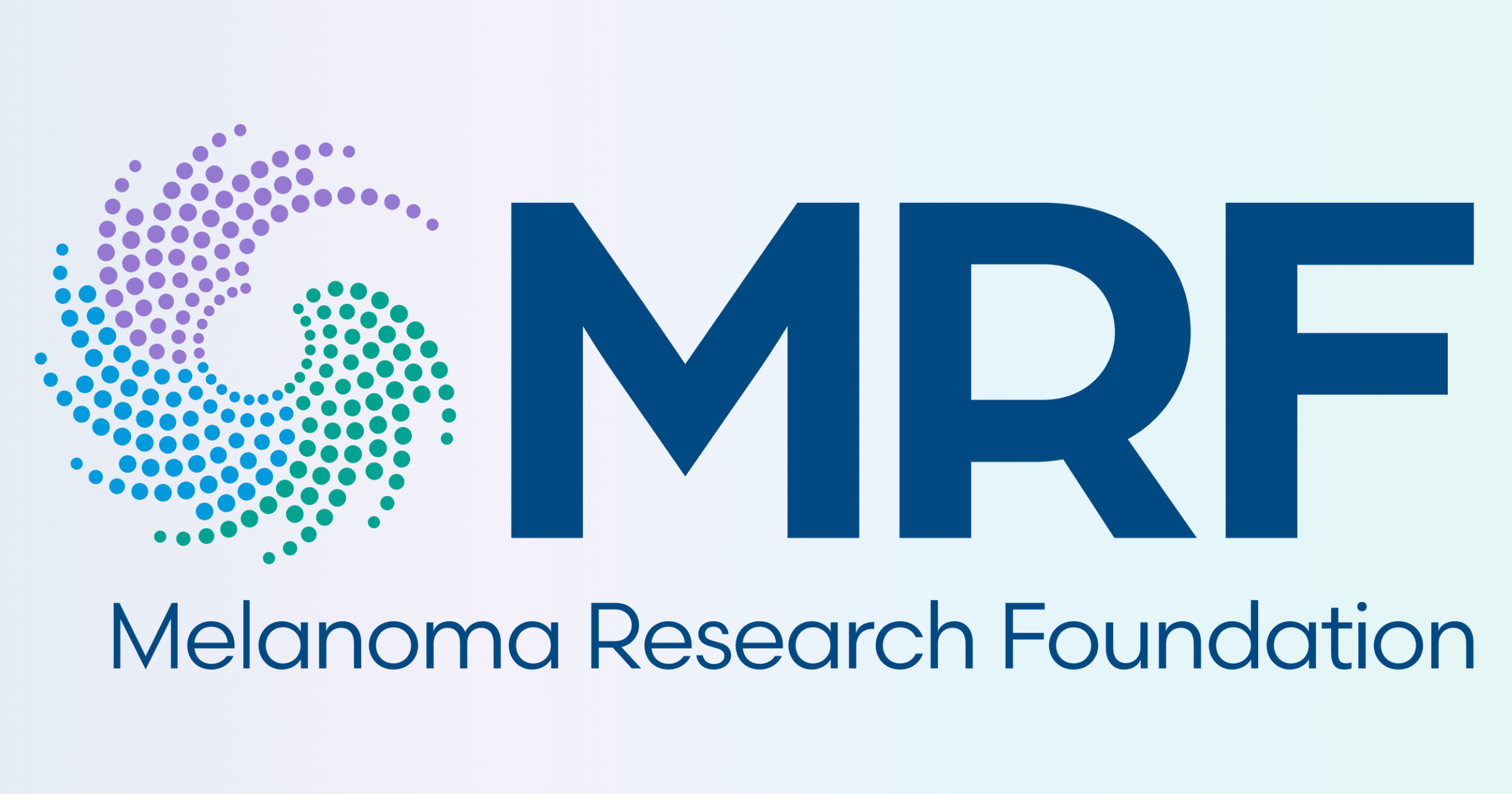13th Annual CURE OM Global Science Meeting Summary

Advancing Ocular Melanoma Research Through the 13th Annual CURE OM Global Science Meeting
CURE OM catalyzed the OM research field through its innovative approach to the 13th Annual CURE OM Global Science Meeting held on Wednesday, October 9, 2024. Each year, CURE OM organizes this global science meeting in conjunction with the Society for Melanoma Research Congress (SMR) to foster interdisciplinary collaboration and innovation aimed at discovering effective treatments—and ultimately a cure—for ocular melanoma. The 2024 gathering brought together leading ocular melanoma researchers and clinicians as well as patients and industry partners to discuss pivotal research, all with the shared goal of improving outcomes for patients.
Key topics included leveraging opportunities and overcoming challenges to advance new targets and preclinical research, adjuvant and neoadjuvant therapies, liver-directed treatments, and cell therapies. The meeting underscored the progress made in ocular melanoma research, highlighting collaborative initiatives to advance therapies and improve patient outcomes, while strategizing how to address the unmet need in the field. Participants reinforced the critical need for ongoing collaboration, data sharing, tumor tissue sharing and addressing implementation and access barriers to drive continued advancements in this rare cancer.
The scientific meeting highlighted significant advancements in ocular melanoma research while also identifying critical areas for further development. Attendees, which included researchers, clinicians, and industry partners stressed the importance of ongoing collaboration, data sharing, and overcoming barriers to clinical trial prioritization and advancement as well as therapy implementation and access.

Panel Summaries
Below you will find summaries of the sessions that took place at the 2024 CURE OM Global Science Meeting that highlight critical and cutting-edge research currently advancing OM research aimed at improving the lives of OM patients.
Patient Panel: Centering patient journeys and perspectives
The event began with an impactful patient panel led by Miriam Kadosh, oncology social worker and MRF’s Director of Education and Patient Engagement. OM patients Eric Roeland, MD and Ashley McCrary shared their personal experiences with OM including physical and emotional challenges, impacts on personal life and career, impacts on family challenges accessing care and perspectives on therapeutic progress and thriving with OM, exemplifying their resilience and advocacy.
Eric Roeland, MD, an oncologist who faced his own diagnosis during medical training, reflected on balancing his personal experience with his professional responsibilities. He emphasized the need for collaboration across institutions and the power of patient voices in healthcare. Ashley McCrary recounted her diagnosis and her experience being part of a unique population in Alabama. Ashley described aspects of life with metastatic disease including traveling weekly to Philadelphia for treatments and the joy and gratitude she experiences with each family milestone. Ashley advocates for research, support, and community awareness around OM. Both Ashley and Eric emphasized that recognizing their own resilience alongside feeling the strength of community support have shaped their perspectives and fueled their hope for advancements in research and collaboration leading to a cure.
Hearing from the patient perspective set the tone for the rest of the day and reminded participants of the importance of bringing the patient voice to the center of everything that is done in the lab and in the clinic.
New Targets/Pre-Clinical Research: Highlighting basic science research with important clinical implications
This session, chaired by Andrew Aplin, PhD from Thomas Jefferson University, focused on innovative early-stage approaches to targeting uveal melanoma. The presentations collectively underscore promising targeted pathways to advance OM therapies.
Vivian Chua, PhD from Edith Cowan University, in Australia, discussed the tumor BAP-1 mutation and described her research that shows how this mutation helps melanoma cells survive in the liver, exploring new treatments to disrupt this process. Adam Dupuy, PhD, from the University of Iowa College of Medicine, highlighted research identifying genes that allow cancer to resist treatment, potentially revealing targets for more effective therapies. Ishan Mehta, MD, from Wellcome Sanger Institute, in the UK, presented a treatment strategy targeting a gene crucial for cancer cells, causing them to die while sparing healthy cells. Edward Hartsough, PhD, from Drexel University College of Medicine in Philadelphia, discussed how BAP1 mutations enable melanoma cells to thrive in iron- and fat-rich environments, identifying a protective protein as a potential new drug target. Narendra Wajapeyee, PhD, from University of Alabama at Birmingham, discussed her research enhancing natural killer (NK) immune cells to target cancer more effectively, finding that blocking certain proteins can render melanoma cells more vulnerable.
Industry partners from Castle Biosciences and Aura Biosciences also participated in this session. Katharina Alsina, PhD from Castle Biosciences discussed a test called DecisionDX-UM, which uses a 15-gene profile from tumor samples to help predict a patient’s risk of cancer spread and ultimately facilitate personalized treatment planning. Finally, Ross Goldstein, MD, MBA from Aura Biosciences shared insights on Bel-sar, a targeted therapy using light-activated treatment to halt tumor growth while preserving vision, currently in Phase III trials. Collectively, these presentations illuminate pathways for more effective, targeted options for OM patients.
Adjuvant/Neoadjuvant Therapies: Advancing treatments to prevent metastasis
In this session led by Rich Carvajal, MD from Northwell Health Cancer Institute, clinician researchers discussed emerging approaches to prevent the spread of OM after initial treatment. The session highlighted innovative strategies, including using therapies effective in metastatic OM as earlier interventions, conducting small-scale trials to identify promising treatments for larger studies, and testing neoadjuvant treatments to assess their impact on preventing recurrence. These initiatives reflect optimism in the field, with a shared goal of advancing toward a cure for OM.
Suthee Rapisuwon, MD presented a study testing nivolumab and ipilimumab in OM patients following treatment of the primary eye tumor for patients who have a high risk of developing metastatic disease (as determined by genetic testing of a tumor biopsy), showing a higher three-year metastasis-free survival rate of 70.4% compared to 43.4% in a control group of patients who did not receive the nivolumab and ipilimumab combination, though 44% of patients experienced severe side effects. Rino Seeder, MD shared results from a series of studies using sunitinib and valproic acid in high-risk patients after the treatment of their primary eye tumor. Interestingly, it appears sunitinib alone had a longer progression free survival time than valproic acid along or in combination with sunitinib. Jennifer Johansen, PharmD, an industry representative from Immunocore, discussed the ADAM trial with tebentafusp to prevent melanoma recurrence, comparing treated patients to those under observation.
This panel emphasized the need for effective therapies to prevent metastasis and the critical role of collaboration in advancing effective treatments for melanoma, fostering a hopeful outlook for new therapies that enhance both survival and quality of life for melanoma patients. To learn more about clinical trials, which centers of excellence are participating in clinical trials, and how to enroll in a trial, visit melanoma.org/patients-caregivers/clinical-trials/.
Liver-Directed Therapies: Stopping metastasis in its tracks
During the panel on liver-directed therapies, led by Marlana Orloff, MD from the Sidney Kimmel Cancer Center, experts presented data on several promising treatment options for metastatic OM to the liver. Jonathan Zager, MD from Moffitt Cancer Center, discussed percutaneous hepatic perfusion (PHP), a treatment that delivers high-dose chemotherapy directly to the liver while minimizing drug exposure in the body outside the liver. PHP has shown encouraging results in controlling liver tumors and prolonging disease-free survival and was approved by the Federal Drug Administration (FDA) in 2023.
Rahul Marpadgarahu, MD, an industry representative from Replimune, introduced RP2, a novel treatment utilizing a modified virus injected directly into OM tumors in the liver. RP2 targets OM cells and activates the immune system. RP2 has demonstrated promising early trial results with some patients experiencing lasting benefits for over a year. Replimune is planning a larger trial to compare RP2 in combination with immunotherapy against standard treatments.
Joe Sacco, MD, from the Clatterbridge Cancer Centre in the United Kingdom, emphasized the need to integrate liver-directed therapies with systemic immune treatments. Dr. Sacco highlighted emerging research, such as the PERIO-01 study, aimed at improving drug delivery to OM metastasized to the liver and enhancing immune responses. All panelists agreed that these therapies signify exciting advancements for OM that has metastasized to the liver, offering hope for improved outcomes and reduced side effects.
Cell Therapies: Taking lessons from cutaneous melanoma to train the immune system to target OM
The Cell Therapies panel was led by Sapna Patel, MD from the University of Colorado Cancer Center and featured melanoma experts from leading cancer centers discussing their experiences and practices with cell therapies for melanoma patients. Panelists included Allison Betof–Warnar, MD, PhD from Stanford University School of Medicine, Meredith McKean, MD from Sarah Cannon Research Institute, and Jose Lutzky, MD from the University of Miami Miller School of Medicine. Discussants shared experiences and frustrations with current cell therapy treatments, ongoing clinical trials, and the need to obtain additional research in OM and the impact of cell therapies. Notable mentions included Amtagvi, a significant therapy for melanoma, and various T-cell engineering trials.
Throughout the discussion, panelists addressed the complexities of, and barriers to implementing cell therapies in melanoma, including patient selection, insurance approval processes, and the importance of efficient care coordination. They acknowledged the logistical challenges often encountered, such as securing operating room slots and ensuring compliance with FDA standards for cell specifications. Furthermore, discussants brought focus to the need for more research and industry support to advance cell therapies for OM. The conversation highlighted the collaborative efforts necessary among healthcare teams to navigate these challenges, ensuring OM patients receive the best possible care. Overall, the session underscored both the promise and the obstacles in advancing cell therapies for melanoma, and OM in particular, and the need to advance research and address barriers to care.
Conclusion
The 13th Annual CURE OM Global Science Meeting exemplified the power of collaboration and the promise of innovation in the fight against ocular melanoma and served as a powerful reminder of the progress made and the challenges that remain in advancing treatments for this rare cancer. This strong focus on advancing collaboration and innovation was set as a priority by CURE OM co-founder, Gregg Stracks, PsyD, when he and his wife, Sara Selig, MD, MPH, founded CURE OM in 2011. Thirteen years later CURE OM continues to push the field forward by bringing together researchers, clinicians, industry leaders, and patients to advancing OM research and improve the lives of OM patients and their loved ones. The 2023 CURE OM Global Science Meeting fostered a shared commitment to advancing treatments, overcoming obstacles, and offering hope to those affected by OM. Through collaborative efforts and united by a common goal, the CURE OM community continues to inspire hope, and remains committed to pushing the boundaries of ocular melanoma research, improving patient outcomes, and ultimately striving for a cure.



